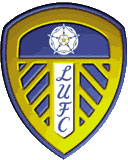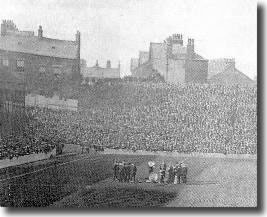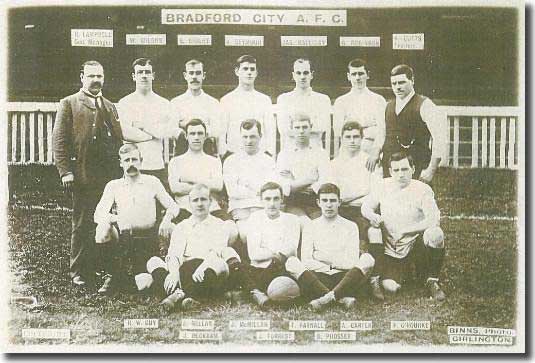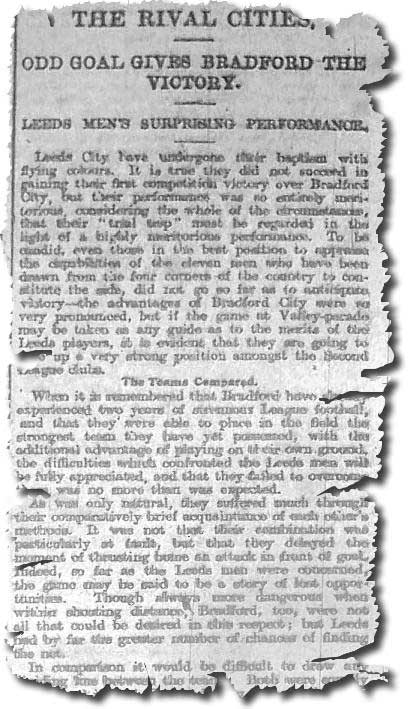 |
 |
 |
 |
 |
 |
 |
 |
 |
Second Division - Valley Parade - 15,000
Scorers: Sadly none
Bradford City: Garvey; Easton, Halliday; Robinson, O'Rourke, Millar; Clarke, McGeachan, Smith, McMillan, Conlin
Leeds City: Bromage; Macdonald, Ray; Morgan, Stringfellow, Henderson; Parnell, Watson, Hargraves, R Morris, Singleton
Their big time debut saw Leeds pitched against West Yorkshire neighbours,
Bradford City, who had been trailblazers of Association football in the
West Riding, and had already spent two seasons in the Second Division,
finishing tenth and eighth. The Bantams, under manager Robert Campbell,
had finished the previous season strongly, dropping just a single point
from their last six matches. Their experience at the top level was expected
to give them the upper hand over the novices of the Peacocks, as the Leeds
Mercury noted: 'To be candid, even those in the best position to appraise
the capabilities of the eleven men who have been drawn from the four corners
of the country to constitute the side, did not go so far as to anticipate
victory - the advantages of Bradford City were so very pronounced. When
it is remembered that Bradford have already experienced two years of strenuous
League football, and that they were able to place in the field the strongest
team they have yet possessed, with the additional advantage of playing
on their own ground, the difficulties which confronted the Leeds men will
be fully appreciated.' Nevertheless, locals flocked to see whether the newcomers could possibly
spring a shock and the gate of 15,000 was well up on Bradford's normal
attendance. The Valley Parade stadium, which had been hewn from a bare
hillside in 1886, made an atmospheric venue, despite having a capacity
of just 18,000. Leeds lined up as expected with left-half James
Henderson playing against the club he had left at the end of the previous
season. Former Burton United goalkeeper Harry
Bromage had built up a good reputation as a first-class custodian,
while Welsh international Dickie Morris
(Liverpool) The same eleven had played the previous weekend in a practice match against
the reserve XI, and had impressed local reporters. The Leeds Mercury
had commented: 'The first-team had the best of matters, and the players
had ample opportunities for displaying their skill. Morris, the Liverpool
international, was much in evidence, and his trickiness and deft passing
to Singleton, his partner
on the left wing, pleased the crowd. Watson and Parnell, too, showed promising
form, and Hargraves, who operated
as centre in the first half, was responsible for opening out some good
movements. The halves and backs also did well, and Bromage, in goal, brought
off some clever saves.' Bradford City, however, were a formidable side and represented a significant
step up for a team that had enjoyed so little time getting to know each
other's style. Their ranks were packed with experienced and charismatic
individuals who would test the Peacocks to the limit. The no-nonsense approach of right-half George 'Geordie' Robinson had
made him a firm favourite with the Valley Parade faithful. He had played
in Bradford's first league game after joining from Nottingham Forest in
June 1903 and was associated with the club for nineteen years. Scottish centre-half Peter O'Rourke was another who had appeared in the
Bantams' first League game, signing from Chesterfield that summer. He
was shortly after to become manager at Valley Parade, leading them to
a Second Division championship in 1908 and an FA Cup triumph in 1911,
returning to the club in 1928 and securing the Third Division North title
a year later. However, the real star of the show was tricky left winger Jimmy Conlin,
a colourful and controversial forward who enjoyed the double distinction
of being Bradford's first England international and their first player
to be sent off. Born in County Durham in 1881, he started his career in
Scottish football and moved from Albion Rovers to Bradford City for £175
in September 1904. He went on to become only the second player in the
world to figure in a £1,000 transfer when he moved to Manchester City
in July 1906. There was an atmosphere of high anticipation as the sides lined up before
an excited and packed Valley Parade crowd, with Bradford's claret and
amber and the blue and old gold of Leeds presenting a vivid wash of colour. Early season rustiness was much in evidence in the opening exchanges
from both sides, and Leeds had also to contend with having only rarely
played together previously. The Peacocks understandably took some time
to settle, with the Yorkshire Post noting, 'The display of the
Leeds men was especially creditable, taking into consideration the fact
that the players were practically strangers to each other's tactics in
serious football.' After an opening fifteen minutes when the Bantams pressed Leeds City
back, play was open and fast in the first half, with the Play was more frenetic after the break, and the fitness of the Bradford
men began to tell as time went on. It had seemed that the match was destined
to finish scoreless, but the Valley Parade side finally managed to force
home their advantage with fifteen minutes to go. The Bantams had been
pressing Leeds hard for some time and had them penned back. The passage
of play was untidy, but John McMillan provoked a real panic as he dribbled
across the area, before feeding outside-right William Clarke. The winger's
centre reached Conlin on the opposite flank, before being turned in again.
There was a mad scramble in the goalmouth, ending when centre-forward
Wallace Smith charged Harry Bromage, knocking the ball from his grasp
to register a goal on his debut appearance for Bradford. It should have been 2-0 shortly afterwards, but the Bradford forwards
were too slow to capitalise when the ball passed right across in front
of goal and the Peacocks were sweating. Leeds City broke away in the closing minutes to exert some pressure on
the home defence, without ever going particularly close and the Bradford
backs withstood all of their opponents' attacks to ensure that it was
their team that emerged victorious from the contest. The Leeds Mercury:
'It was the first appearance of Easton for Bradford, and he must be said
to be one of Mr Campbell's most notable captures. An extremely strong
kicker, both off the ground and in the air, he plays with most disconcerting
dash, and time and time again he cleared in a most brilliant fashion.' It had been a fascinating contest, even if not of a particularly high
quality, with an enthusiastic crowd kept on the edge of their seats throughout.
The Peacocks had put up a strong showing and come close to a share of
the points, prompting the Leeds Mercury to comment: 'Leeds City
have undergone their baptism with flying colours … The directors of the
Elland Road organisation were more than pleased with the display of their
men. Every confidence has been placed in the manager of the club, Mr G
Gillies, and that he has been able to achieve so much in building up the
team must have strengthened his position materially. Taking everything
into consideration, he has gained a great triumph.' The Yorkshire Post was similarly taken with events and said 'the
general play of the team was full of promise, and lack of experience of
each other's play rather than any defect in ability was responsible for
the defeat. Leeds City have no reason to feel disappointed with the first
performance of their men. Their greatest fault was to finish in front
of goal. Had they taken advantage of the chances that came their way,
a very different story would have to be told. Bromage more than once proved
himself a capable defender of goal.' Yorkshire Evening Post: 'Truth to tell, the Leeds City were fully
entitled to share the honours. They played the better game, and it was
only a certain lack of finish in front of goal which prevented them scoring.' Leeds Mercury: 'Ray, the captain of the Leeds team … played a
sterling game, being cool and collected, and overcoming many difficulties
by his sound judgement … There could be no two minds as to the strength
of the half-back line, the Leeds trio holding an advantage throughout.
In Stringfellow, the Leeds club have got a highly skilled centre, who
fully appreciates his duties, both as to attack and defence, whilst Morgan
and Henderson hungered after the ball in a manner calculated to put any
wing man off his game. It was rather a trying experience for Henderson
appearing against his old club for the first time, and though he undoubtedly
put a good deal of spirit into his play, the attitude of a certain section
of the crowd towards him was unjustifiable. 'With regard to the Leeds forwards, whilst the inside men did their work
creditably, the ball did not come smartly enough from the wings. Singleton
did not appear to get into his right stride, and Parnell was not entirely
happy with Watson, his partner. Accustomed to the go-ahead methods of
Bloomer, whose great aim is to make straight for goal after receiving
the ball from the wing, he was not always prepared for a return pass,
and thus often appeared at a disadvantage. This defect, however, can be
readily rectified, and taking the line as a whole, it gives promise of
developing into a powerful force.' The talent of the City forwards had been much in evidence and they had
put together some decent combinations. Clearly, there was much to learn
for this new young club, but they had quickly managed to build some good
team spirit and understanding of each other's play. Their debut in top-class
football had gone as well as their supporters could have hoped, apart
from the result, and a decent start had been made to their first season
in top class football. There was every reason to look forward with confidence
to the challenges to come. Leeds City were very much up and running.  As
the eleven men of Leeds City lined up on 2 September 1905 along with all
the other hopeful teams, ready for the challenge of a new Football League
season, the men behind the fledgling club could reflect on a startling
twelve months of progress. A little more
than a year previously, Leeds City Association Football Club had been
formed at a meeting in the Griffin Hotel on Boar Lane, and had appointed
Gilbert Gillies its first manager
in March, a few short weeks before being elected into the newly expanded
Second Division. Gillies, fresh from setting his former club Chesterfield
on their way to a best ever fifth place finish in Division Two, had spent
the spring and summer building up a playing squad, and hopes were high
for a good debut in first class football.
As
the eleven men of Leeds City lined up on 2 September 1905 along with all
the other hopeful teams, ready for the challenge of a new Football League
season, the men behind the fledgling club could reflect on a startling
twelve months of progress. A little more
than a year previously, Leeds City Association Football Club had been
formed at a meeting in the Griffin Hotel on Boar Lane, and had appointed
Gilbert Gillies its first manager
in March, a few short weeks before being elected into the newly expanded
Second Division. Gillies, fresh from setting his former club Chesterfield
on their way to a best ever fifth place finish in Division Two, had spent
the spring and summer building up a playing squad, and hopes were high
for a good debut in first class football. and
Bob Watson (Woolwich Arsenal) were
noted inside-forwards with decent Football League experience. Outside-right
Fred Parnell had been a prolific provider of crosses to England international
Steve Bloomer at Derby before losing his place there and Gillies had gone
back to his former club Chesterfield to sign full-back
Dick Ray, whom he appointed captain.
and
Bob Watson (Woolwich Arsenal) were
noted inside-forwards with decent Football League experience. Outside-right
Fred Parnell had been a prolific provider of crosses to England international
Steve Bloomer at Derby before losing his place there and Gillies had gone
back to his former club Chesterfield to sign full-back
Dick Ray, whom he appointed captain. advantage
switching rapidly between the sides. Leeds hit the crossbar after a free
kick by centre-half Harry Stringfellow,
and might easily have broken the deadlock, although Bromage was the busier
of the two keepers. The two teams reached the interval without a goal
between them, with most of the action being confined to midfield sparring.
advantage
switching rapidly between the sides. Leeds hit the crossbar after a free
kick by centre-half Harry Stringfellow,
and might easily have broken the deadlock, although Bromage was the busier
of the two keepers. The two teams reached the interval without a goal
between them, with most of the action being confined to midfield sparring.